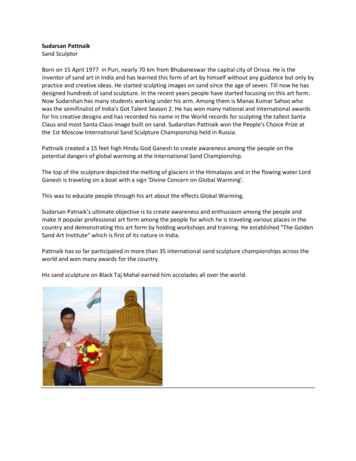
Transcription
Sudarsan PattnaikSand SculptorBorn on 15 April 1977 in Puri, nearly 70 km from Bhubaneswar the capital city of Orissa. He is theinventor of sand art in India and has learned this form of art by himself without any guidance but only bypractice and creative ideas. He started sculpting images on sand since the age of seven. Till now he hasdesigned hundreds of sand sculpture. In the recent years people have started focusing on this art form.Now Sudarshan has many students working under his arm. Among them is Manas Kumar Sahoo whowas the semifinalist of India's Got Talent Season 2. He has won many national and international awardsfor his creative designs and has recorded his name in the World records for sculpting the tallest SantaClaus and most Santa Claus image built on sand. Sudarshan Pattnaik won the People's Choice Prize atthe 1st Moscow International Sand Sculpture Championship held in Russia.Pattnaik created a 15 feet high Hindu God Ganesh to create awareness among the people on thepotential dangers of global warming at the International Sand Championship.The top of the sculpture depicted the melting of glaciers in the Himalayas and in the flowing water LordGanesh is traveling on a boat with a sign 'Divine Concern on Global Warming'.This was to educate people through his art about the effects Global Warming.Sudarsan Patnaik’s ultimate objective is to create awareness and enthusiasm among the people andmake it popular professional art form among the people for which he is traveling various places in thecountry and demonstrating this art form by holding workshops and training. He established "The GoldenSand Art Institute” which is first of its nature in India.Pattnaik has so far participated in more than 35 international sand sculpture championships across theworld and won many awards for the country.His sand sculpture on Black Taj Mahal earned him accolades all over the world.
Bose KrisnamachariPainterBorn in Kerala, 1963, Bose Krishnamachari completedhis BFA from the JJ School of Art, Mumbai, beforedoing a Masters from Goldsmiths College, University ofLondon.Krishnamachari was born in Kerala, a place which hassince 1947 espoused a humanitarian Marxism agendathat fights against the status of disempowerment byrecognizing people of all castes, classes, religions,ethnicities, and gender. Kerala has also implemented a strategic educational policy that has gonebeyond the normalized frame of Indian national strategies of positive discrimination. Through hisartwork, Krishnamachari employs this idea of reform and of the state government’s mission to worktowards the empowerment of these victims. Other works in Ghost include the 108 photographs oflike minded individuals whose partial participation in the artist’s life forms a network of friends andloved ones. In highlighting these specters of his world, Krishnamachari attempts to keep alive thememory of his encounters, and however unsettling they may be, they remain placed, rather thendisplaced, as part of his ongoing, living experience.Krishnamachari’s works are complex, major, even dramatic, encounters of unsettledreconsiderations by the opponents of the middle class. These works carry with them a panoramicreading beyond the displaced gaze that usually forbids further consideration and personalization ofthe mass of others. Krishnamachari constructs memorable works concerning the level of productionof meaning and how meaning straddles over memory and recollection. In evaluating the othersamongst us and in employing the other as a subject constantly bounded by our own fixity,Krishnamachari unabatedly exposes the gradual sedimentation of class and wealth. The pain of ourlooking at those whom are economically less fortunate and who are restrained in menialsubservience through the use of severe threats is a bald reminder of how power survives within ourhomes, our offices, our cities, our countries, and within us, as memory and as process.” – ShaheenMerali“This remarkable quality of being simultaneously a prodigious producer of work, while also being anintrepid collector of information about fellow-producers (or might one say “whole-time workers”)and a genuine “connector” of people, patrons and projects makes Bose in 2008 an obsessiveveritable one-man army with sophisticated systems of communication and the ability to detect arange of frequencies by always keeping an ear to the ground as it were. Bose plays the role of a“connector” in a manner that remains unprecedented and as yet not outdone in the world ofcontemporary art in the India of today. Bose’s is a commemoration of living artists, and this aspectof the De-Curating enterprise, along with his other curatorial ventures over the past decade, reflectthe pathology of an artist who is hard-wired to record, reflect, memorialize (and perhaps flatten inthe process), the current condition of contemporary society and its art practices.Bose is wholly conscious of the significance of history (both personal and socio-political) in a seriousand considered set of positions that any artist is compelled to adopt in order to retain an elastic,
charged space of praxis within the contemporary moment. In the tiffin-carrier works, as in themuseum project, Bose retains this self-consciousness and highlights it. I use another quote from thecatalogue for the show De-Curating (which required the artists to provide a written statement,perhaps asking them about the function of memory) to emphasize that the self-consciousness oneencounters continually in Bose’s work is not by any means, exclusive to himSolo Shows1989 Kerala Kalapeethom, Kochi1990 Sir JJ School of Art, Mumbai1991 Music of the Cubes, British Council Gallery1992 AmUseuM, Jehangir Art Gallery, Mumbai, Sakshi Gallery, Bangalore1993 AmUseuM, Park Sheraton, Chennai1995 Objects of Attention, Inaugural show of Academy of Fine Arts and Literature, New Delhi1996 DANDY at Lakeeren and YB Chavan Centre, Mumbai1999 AmUseuM Memoirs, NGMA, Mumbai1999 Field Sakshi, Sakshi Gallery, Mumbai2003 DE CURATING-India Contemporary Artists, Sakshi Art Gallery, Mumbai, Sumukha, Bangalore andDurbar Hall, Kochi2004 Vanitas Vanitatum, shown alone at Kashi Art Gallery, Kochi, before joining a group show inMumbai2005 EXIST at Jehangir Art Gallery2006 GHOST/ TRANSMEMOIR (preview at Kitab Mahal, Mumbai); show at Gallery ArtsIndia (now Aicon),New York2007 LaVA [Laboratory of Visual Arts, a traveling installation project], Mumbai, Bangalore, Kolkata,Kochi, Baroda and New DelhiBose Krishnamachari lives and works in Mumbai.
-------------
Krishen KhannaPainterBorn in Lyallpur (now Faislabad, Pakistan), in pre partition India in 1925,Krishen Khanna moved to Shimla during the partition. In Lahore Khannahad attended evening classes at the Mayo School of Art. After arriving inIndia he took up a post with the Grindlays Bank and was placed inMumbai. Once there Khanna was invited to join the Progressive Artists'Group with whom he remained in active association for the rest of histime. In Mumbai he held his first major exhibition and sold his firstpainting to Dr. Homi Bhabha for the Tata Institute of FundamentalResearch.Khanna was awarded the Rockefeller Fellowship in 1962 and was Artist in Residence at the americanUniversity in Washington in 1963-64. Apart from several one man shows he has participated in groupshows like the Tokyo Biennale 1957 and 196 1, the Sao Paulo Biennale 1960, the Venice Biennale 1962,the Festival of India in the then USSR and in Japan in 1987 and 19 88. Khanna has held several importantpositions in decision-making bodies of the Lalit Kala Akademi, National Gallery of Modem Art andRoopanker Museum, Bhopal. He was awarded the Padma Shri in 1996.Making a gestural impact on the canvas Khanna's masterful deployment of paint to evoke the humansituation is unmatched. The thick impasto surface often seems like a prism through which figures can bediscerned as if in memory or in remote areas of childhood. Khanna lives and works in New Delhi.Last ----------------------------------
Rameshwar SinghPainterRameshwar Singh was born in Rajasthan, and received his M.A. in drawing andpainting from Udaipur University in 1982. He has a fascination for antiquity.The subject matter may be old-fashioned, but the treatment is novel. His workis very much keeping in tune with times. Through his paintings, he pays tributeto our cultural tradition that, he believes, can never be outdated. Blending hepast with the present and striking a right balance in the process has helpedhim in establishing his identity.About his work, fellow painter F. N. Souza has commented "His paintings are very compact; there''s a lotin them: figures, forms, and mythological content. Very colourful too.The forms are carefully constructed; there''s craftsmanship in his work, and skill. Sort of magic mantrasand omens appear mysteriously in Rameshwar''s paintings.His main source of inspiration is ancient scriptures, architecture and obviously his own state, Rajasthan,which is rich with art traditions. Old calligraphy, scripts and architecture also seize his mind. Thesefrequently appear in his work. Artifacts like vessels, music instruments, games, toys and prints thatspeak so much of our rich tradition have a pulsating effect on him.He paints for deriving aesthetic pleasure. His work is neither a statement on anything nor it means tofight any notions or traditions. There are bodies halved into the shapes of human and animal. Strangeobjects fly around. An antique Roman clock invariably features somewhere. Everything seems likehaving been caught in a time warp. A true communication or communion is on between one colour andanother, between object and subject and things and thoughts.Critic Umesh Verma has written, "Singh is a virile painter from Rajasthan. Calligraphic textures andthrough inner alchemic processing he creates highly decorative folkishly sweet objects and paintings. Hisprocess is more or less scientific and has obvious overtones of Rajasthan. Sweetness and mirage are thereason for the essence of his visuals. He invokes poetic-Lingo."His canvasses are textured and layered over and over. Perhaps he hates leaving any empty space oncanvass and embellishes and decorates every object. He profusely uses different scriptures like Arabic,Persian, Urdu and even English. The couplets used don''t make any statement. They on their own don''trepresent anything, but he does not use the symbols for the heck of it. To decipher them, they need tobe viewed in totality, keeping in mind the objects painted. Otherwise, they are there for purelydecorative purpose. A line with a shadow, cutting across the canvass, gives a sense of perspective to thepainting. The concept is similar to one employed in old scrolled miniatures. Lines make a viewer stopand ponder; line-break the monotony and depth. Medium is not a barrier to him.In the paintings with a mythological theme, he depicts different forms of Lord Ganesha, Lord Krishna,Goddess Durga and the Sun God. Art critic Keshav Malik, who has reviewed his work from early days,writes, "Singh''s apparitions from the cultural past cause nostalgia in viewers. This same dreamscapebrims with the personae of charming figments, of birds, fish, beast and humans, of objects from bothpast and present. Here there are motifs from the foregoing Rajasthani painting as well as images ofmundane objects of the day. All these have blended thoroughly." Malik adds, "No feel of over-crowding
or of congestion. The ecology of his compositions, in other words, is just right; it suggests theinterdependence of each on all, and of live and let live. This at least was the earlier Indian culturalmethodology."In an interview, he told that he does not always go by set patterns. Some of his paintings extend to orbeyond the frame. He started with abstract before slowly switching to figurative. May be, he has nowcome a full circle as he again feels like doing abstract. While concerning about declining art traditions, hefeels that puppetry, folk dances, scroll painting, tattoo, etc belong to the rich art tradition. If noattention is provided to their revival, these will simply ------------------------------------
Dhiraj ChoudhuryPainterDhiraj Choudhury was born on 1936 at then Bengal, now Bangladesh. Hewas a student of Government College, Darjeeling and the Principal Dr. K.D.Ghosh encouraged him to follow up his dreams to become an artist.Later he was admitted to College of Arts and Crafts, Calcutta and DelhiPolytechnic (Delhi College of Art). He has taught from 1962 to 1996 inWomen Polytechnic and Department of Painting, Delhi College of Art,University of Delhi. He has ameliorated Calcutta Painters Society by being amember, of Artists Forum, Society of Contemporary Artists, AIFACS, NewDelhi. Dhiraj Choudhury has founded Quartet Artist and Line , a groupdevoted to drawing.Dhiraj Choudhury has more than eighty exhibitions, among which sixteen are international, which issufficient enough to understand his popularity as a painter. UK, USA, France, Germany, Switzerland,Singapore are the countries where his foreign shows were arranged. In 1979 an exhibition in Genevawith Miro and Dali added a feather to his cap. Dhiraj Choudhury has participated in many National andInternational Exhibitions and received many awards including National Award on 1995.On the same yearhe had Exhibitions of his major works at Birla Academy of Art & Culture, Calcutta and All India Fine Arts& Crafts Society at New Delhi.In 1998 the shows were 50 Years Struggle for Freedom , a retrospective at Rabindra Bhavan and LalitKala Akademi of New Delhi. On 1999 there was At The Threshol
for his creative designs and has recorded his name in the World records for sculpting the tallest Santa Claus and most Santa Claus image built on sand. Sudarshan Pattnaik won the People's Choice Prize at the 1st Moscow International Sand Sculpture Championship held in Russia. Pattnaik created a 15 feet high Hindu God Ganesh to create awareness among the people on the potential dangers of .











